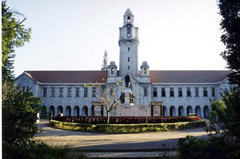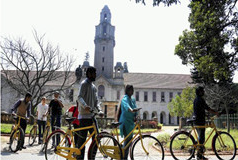From June 12-14, 2014, the international conference "Design for Sustainable Well Being and Empowerment“ took place at the premier Indian tertiary education and research institution, the Indian Institute of Science (IISc Bangalore). About 250 participants from all over the globe were discussing the following topics:


(IISc campus)
Perceptions of well-being and empowerment, normative approaches in design for well-being, sustainability and well-being, individual versus collective well-being and empowerment, role of ethics in design, pedagogical design tools, novel design methodologies/ frameworks/ methods/ pedagogy, adaption and evaluation of design methodologies/ frameworks/ methods for well-being and empowerment, design & innovation for sustainability, successful design & innovation: role of stakeholders, extending design, grass-root innovations and the role of design in the path from invention to innovation.
Ille C. Gebeshuber, physics professor at the National University of Malaysia and the Vienna University of Technology in Austria, Europe, and member of the ISBE board of directors, was invited to IISc to give a keynote at this event and share her views and approaches in a panel discussion and virtual jungle expeditions. In her keynote address “Bridging theory to practice: Biomimetic nanoscience and nanotechnology to design for society” Prof. Ille treated global challenges for humankind and how to address them with new ways of doing engineering, sorting and accessing human knowledge and educating future generations.
(Prof. Ille C. Gebeshuber in the KL Butterfly Park, ready to investigate
functional structural colours in butterflies and moths.)
(Prof. Ille C. Gebeshuber in the Malaysian rainforest, with a rare
Rafflesia plant in full bloom)
Of specific interest in the presentation was our current and future ways of dealing with resources, manufacturing and transport. Biomimetic nanoscience and nanotechnology are important emerging fields that increasingly influence our daily lives. Learning from biomineralisation for example might inspire a new way of mining: more than 70 different minerals are produced by organisms, at ambient conditions, with the help of proteins rather than high temperature. Biominerals are interesting from the material perspective, but even more so concerning structure-based functionalities such as superior toughness and strength. Intriguing examples for biomineralisation are hydrated silica shells produced by diatoms (“glass-making” algae), magnets with atomic precision produced by magnetotactic bacteria and organisms that accumulate Gold from seawater and produce nanocrystals of this precious element. Learning from structural colours might remove pigments and additional coloration layers from our products: tiny structures in organisms (size: on the order of the wavelength of visible light, i.e. some hundreds of nanometers) play with the light and thereby generate colours via physical phenomena such as scattering and multilayer reflections. As opposed to pigment coloration, such structural colours do not bleach and can furthermore be functionalised (i.e. made reactive to external stimuli such as temperature, gas concentration, electrical voltage), for exciting applications in technology, medicine and the arts – all without pigments made from potentially toxic chemicals.
As Prof. Ille mentioned, in functioning ecosystems (as opposed to our current human society) there is no rich and no poor. Resources are locally available for all, and are harvested and processed in benign ways that result in products that, when at the end of their lifespan, may serve as food or fertiliser for the others. Biomimetic inspiration that transfers the established integrative approach of living nature regarding structure, functionality and beauty to artefacts (technology and products) promises great advancement for design to positively support well-being for the underprivileged.
Ille took faculty, MSc and PhD students from mechanical engineering and product design as well as kids with ages up to 14 years old on various educational biomimetic expeditions to wilder parts of the IISc campus, which had been untouched for decades. Off the beaten paths, the participants were watching, looking and learning from materials, structures and processes in living nature regarding transfer of the lessons learnt to their respective fields and interests.
Copyright © 2024 International Society of Bionic Engineering All Rights Reserved
吉ICP备11002416号-1



 Attachment:
Attachment:






